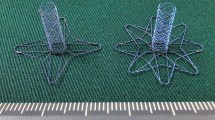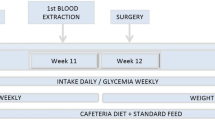Abstract
Background and Aims
Minimally invasive therapies for obesity are a bridge between lifestyle interventions and bariatric surgery. We developed a novel device to reduce weight gain rate and evaluated its safety and efficacy in juvenile pigs.
Methods
The intragastric satiety-inducing device (ISD) comprises a self-expandable esophageal metal stent connected to a star-shaped disc placed in the stomach fundus. Eight juvenile pigs were randomized into ISD (n = 5) and control (n = 3) groups. Body weight and serum ghrelin hormone were monitored weekly for 6 weeks. One pig was followed up for 4 additional weeks (rebound pig) after ISD removal. Histological examination and immunohistochemistry for the interstitial cells of Cajal (ICCs) were performed.
Results
ISD placement was successful in all pigs. Two ISDs (40%) migrated at 4 and 5 weeks after placement. Weight gain rates were significantly lower in the ISD group than in the control group from week 1 to 6 but were higher in the rebound pig than in a control pig from week 7 to 10. Mean ghrelin hormone level was higher in the control group than in the ISD group from week 1 to 6. ISD induced reversible inflammatory changes in the esophagus and stomach fundus. The number of ICCs was lesser in ISD pigs than in control and rebound pigs.
Conclusions
ISD placement is feasible and safe in juvenile pigs. It decreases weight gain rate but induces reversible inflammatory reaction and tissue hyperplasia. Its mechanism may be related to pressure exertion on the stomach fundus or gastric motility alteration.






Similar content being viewed by others
References
Klobucar Majanovic S, Brozovic B, Stimac D. Bariatric endoscopy: current state of the art, emerging technologies, and challenges. Expert Rev Med Devices. 2017;14(2):149–59. https://doi.org/10.1080/17434440.2017.1281741.
Lee PC, Dixon J. Medical devices for the treatment of obesity. Nat Rev Gastroenterol Hepatol. 2017;14(9):553–64. https://doi.org/10.1038/nrgastro.2017.80.
Myall P. New endoscopic stent can lead to 100% EWL [Internet] London: bariatric news; c2012 [updated 2012 Jun 5; cited 2020 Jan 21] Available from: https://bariatricnewsnet/?q=node/102.
Carrano FM, Peev MP, Saunders JK, et al. The role of minimally invasive and endoscopic technologies in morbid obesity treatment: review and critical appraisal of the current clinical practice. Obes Surg. 2019;30:736–52. https://doi.org/10.1007/s11695-019-04302-8.
Abu Dayyeh BK, Edmundowicz SA, Jonnalagadda S, et al. Endoscopic bariatric therapies. Gastrointest Endosc. 2015;81(5):1073–86. https://doi.org/10.1016/j.gie.2015.02.023.
Foote J BR, Trevino J, Kemmeter P, Fred Walburn, PhD, Peter Freswick, BS, Grand Health Partners, Grand Rapids MI, Sentinel Group, Grand Rapids MI, Hospital Galenia, Cancun Mexico ET09 A novel endoscopic reversible bariatric device: animal results and initial human clinical experience. SAGES 2009 Annual meeting (Phoenix, AZ).
Park J-H, Bakheet N, Na HK, et al. A novel full sense device to treat obesity in a porcine model: preliminary results. Obes Surg. 2019;29(5):1521–7. https://doi.org/10.1007/s11695-018-03692-5.
Cheskin LJ, Hill C, Adam A, et al. Endoscopic sleeve gastroplasty versus high-intensity diet and lifestyle therapy: a case-matched study. Gastrointest Endosc. 2019; https://doi.org/10.1016/j.gie.2019.09.029.
Metzger R, Neugebauer A, Rolle U, et al. C-Kit receptor (CD117) in the porcine urinary tract. Pediatr Surg Int. 2008;24(1):67–76. https://doi.org/10.1007/s00383-007-2043-2.
Pérez-Hernández AI, Catalán V, Gómez-Ambrosi J, et al. Mechanisms linking excess adiposity and carcinogenesis promotion. Front Endocrinol (Lausanne). 2014;5:65. https://doi.org/10.3389/fendo.2014.00065.
Camilleri M. Peripheral mechanisms in appetite regulation. Gastroenterology. 2015;148(6):1219–33. https://doi.org/10.1053/j.gastro.2014.09.016.
Al-Shboul OA. The importance of interstitial cells of cajal in the gastrointestinal tract. Saudi J Gastroenterol. 2013;19(1):3–15. https://doi.org/10.4103/1319-3767.105909.
Sanders KM, Kito Y, Hwang SJ, et al. Regulation of gastrointestinal smooth muscle function by interstitial cells. Physiology (Bethesda, Md). 2016;31(5):316–26. https://doi.org/10.1152/physiol.00006.2016.
Yun H-Y, Sung R, Kim YC, et al. Regional distribution of interstitial cells of Cajal (ICC) in human stomach. Korean J Physiol Pharmacol. 2010;14(5):317–24. https://doi.org/10.4196/kjpp.2010.14.5.317.
Ngamruengphong S, Thompson E, McKnight M, et al. Endoscopic full-thickness muscle biopsy for rectal tissue sampling in patients with severe gut motility disorders: an initial experience (with video). Gastrointest Endosc. 2019;89(6):1242–7.e1. https://doi.org/10.1016/j.gie.2019.01.001.
Lin L, Nuotio-Antar AM, Ma X, et al. Ghrelin receptor regulates appetite and satiety during aging in mice by regulating meal frequency and portion size but not total food intake. J Nutr. 2014;144(9):1349–55. https://doi.org/10.3945/jn.114.191171.
Tuero C, Valenti V, Rotellar F, et al. Revisiting the ghrelin changes following bariatric and metabolic surgery. Obes Surg. 2020;30(7):2763–80. https://doi.org/10.1007/s11695-020-04601-5.
Muruzábal FJ, Frühbeck G, Gómez-Ambrosi J, et al. Immunocytochemical detection of leptin in non-mammalian vertebrate stomach. Gen Comp Endocrinol. 2002;128(2):149–52. https://doi.org/10.1016/s0016-6480(02)00072-2.
Funding
This study was supported by a grant from the Korean Health Technology R&D Project, Ministry of Health & Welfare, and Republic of Korea (grant no. HI18C0631 to H.Y.J.) as well as by a grant (2016-7017) from the Asan Institute for Life Sciences, Asan Medical Center, Seoul, Korea.
Author information
Authors and Affiliations
Corresponding authors
Ethics declarations
Conflict of Interest
Mouen A. Khashab is a consultant for Boston Scientific, Olympus America, and Medtronic and is on the advisory board for Boston Scientific and Olympus. He has received research support from Cook Medical. Vivek Kumbhari is a consultant for Apollo Endosurgery, Boston Scientific, Medtronic, Pentax and ReShape Life Sciences. He has received research support from Erbe and Apollo Endosurgery. All other authors declare that they have no conflict of interest.
Ethical Approval
All applicable institutional and/or national guidelines for the care and use of animals were followed.
Additional information
Publisher’s Note
Springer Nature remains neutral with regard to jurisdictional claims in published maps and institutional affiliations.
Rights and permissions
About this article
Cite this article
Bakheet, N., Na, H.K., Park, JH. et al. A Novel Intragastric Satiety-Inducing Device to Inhibit Weight Gain in Juvenile Pigs: a Pilot Study. OBES SURG 30, 4643–4651 (2020). https://doi.org/10.1007/s11695-020-04930-5
Received:
Revised:
Accepted:
Published:
Issue Date:
DOI: https://doi.org/10.1007/s11695-020-04930-5




